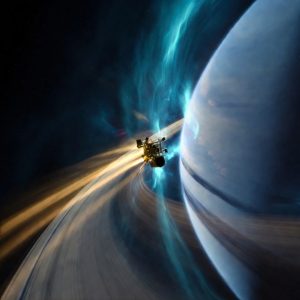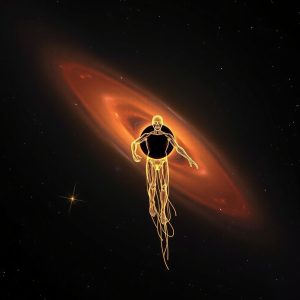
New Study Uncovers Moon’s Iron Secrets: Solar Wind and Micrometeorite Impact Role Revealed in Lunar Nanoparticle Formation
The surface of the Moon has long been a subject of fascination for scientists, with its rugged terrain and mysterious composition sparking intense interest. Recently, researchers have made a groundbreaking discovery that sheds light on the formation mechanisms of metallic iron nanoparticles on the lunar surface. By analyzing data from the Chang’e-5 mission, the team has uncovered the role played by solar wind irradiation and micrometeorite impacts in shaping the optical properties of airless bodies in our solar system.
The study’s findings are nothing short of remarkable, revealing that the formation of metallic iron nanoparticles on the Moon is a complex process governed by two distinct processes: solar wind irradiation and micrometeorite impacts. The researchers’ conclusions are based on an exhaustive analysis of glass beads returned by the Chang’e-5 mission, which can preserve iron particles of different sizes ranging from about 1 nanometer to 1 micrometer.
According to the study, small npFe0 (nanoparticles of iron) were formed through solar wind irradiation, while large npFe0 were formed through micrometeorite impacts. The researchers propose that these two processes occur independently, resulting in different-sized npFe0 with distinct optical effects. This groundbreaking discovery has far-reaching implications for understanding the behavior of airless bodies in our solar system.
One of the most significant implications of this study is its potential to provide valuable insights into predicting the color variations of the lunar surface or asteroids in complex space environments. By understanding the role played by solar wind irradiation and micrometeorite impacts, scientists can gain a deeper appreciation for the dynamic processes that shape the surfaces of airless bodies.
The discovery also highlights the importance of continued research into the formation mechanisms of metallic iron nanoparticles on the Moon. As our understanding of these processes grows, so too does our knowledge of the complex interplay between solar wind irradiation and micrometeorite impacts in shaping the optical properties of airless bodies.
The Science Behind Lunar Nanoparticle Formation
At the heart of this study lies a fundamental question: how do metallic iron nanoparticles form on the Moon? To answer this, researchers turned to the Chang’e-5 mission, which returned glass beads from the lunar surface. These beads provided an unparalleled opportunity for scientists to study the formation mechanisms of metallic iron nanoparticles in situ.
Using advanced instrumentation and sophisticated analytical techniques, the team was able to identify iron particles of different sizes ranging from about 1 nanometer to 1 micrometer. By analyzing the chemical composition and optical properties of these particles, researchers were able to distinguish between solar wind irradiation-induced and micrometeorite-impact-induced npFe0.
Solar wind irradiation, the process by which high-energy particles from the Sun interact with the lunar surface, was found to produce small npFe0. These particles are formed when iron atoms on the lunar surface are ionized by solar winds, resulting in the creation of nanoparticles. In contrast, micrometeorite impacts were found to produce larger npFe0.
The team’s analysis revealed that the size and optical effects of these particles depend on their formation mechanism. Small npFe0 exhibit distinct spectral features, while large npFe0 show different absorption characteristics. These findings have significant implications for understanding the behavior of airless bodies in our solar system.
Implications for Understanding Airless Bodies
The discovery that metallic iron nanoparticles are formed through both solar wind irradiation and micrometeorite impacts has far-reaching implications for understanding the optical properties of airless bodies. By studying these processes, scientists can gain a deeper appreciation for the complex interactions between solar winds, micrometeors, and planetary surfaces.
This research also highlights the importance of continued exploration and analysis of the Moon’s surface. As we continue to unravel the mysteries of lunar nanoparticle formation, so too will we gain a better understanding of the complex processes that shape airless bodies in our solar system.
The Future of Lunar Research
As our knowledge of metallic iron nanoparticle formation grows, so too does our appreciation for the dynamic nature of airless body surfaces. This research has significant implications for future lunar exploration and analysis, offering new avenues for studying the optical properties of planetary surfaces.
Future missions to the Moon will benefit greatly from a deeper understanding of these processes, providing valuable insights into predicting color variations on the lunar surface. The discovery also highlights the importance of continued research into the formation mechanisms of metallic iron nanoparticles on airless bodies.
Conclusion
The study’s findings offer a new perspective on the complex interactions between solar winds, micrometeors, and planetary surfaces. By understanding the role played by these processes in shaping the optical properties of airless bodies, scientists can gain a deeper appreciation for the dynamic nature of our solar system.
As we continue to explore and analyze the Moon’s surface, so too will we unravel the secrets of metallic iron nanoparticle formation on airless bodies. The discovery has significant implications for future lunar research, offering new avenues for studying the optical properties of planetary surfaces.
The study’s findings are a testament to the power of interdisciplinary research, combining advanced instrumentation, sophisticated analytical techniques, and innovative thinking to reveal the intricate mechanisms governing airless body surfaces. As we continue to push the boundaries of scientific knowledge, so too will we gain a deeper understanding of our place in the universe.





I’m not saying I’ve been moonstruck by this study, but… seriously though, who wouldn’t be fascinated by the discovery that solar wind irradiation and micrometeorite impacts are responsible for creating those tiny iron nanoparticles on the lunar surface? It’s like a cosmic game of ‘pinball’ where particles get flung around, sticking to each other and forming new compounds.
As an expert in space research (okay, I’ve just been following this stuff for years), I’d like to add that this study has significant implications for understanding the color variations on airless bodies. It’s not just about predicting the colors of rocks on the Moon or asteroids; it’s about grasping how these dynamic processes shape our entire solar system.
Here are some expert tips from my own experience:
1. Solar wind irradiation is like a cosmic sandblaster: Be careful when analyzing data from this process, as it can create tiny iron particles that are difficult to detect.
2. Micrometeorite impacts are like tiny, high-speed collisions: These events can create larger iron particles, which might be easier to spot but require more sophisticated analysis techniques.
3. Interdisciplinary research is key: To truly understand these processes, scientists need to combine expertise from various fields, including planetary science, materials science, and astronomy.
So, there you have it – a few expert tips from someone who’s been following this study with bated breath (or should I say, ‘moon-breath’?). Keep exploring, keep analyzing, and who knows? We might just unravel the secrets of our universe!
Bryson makes a great point about the implications of this study on understanding color variations on airless bodies. His analogy of solar wind irradiation being like a cosmic sandblaster is especially apt, and it highlights the importance of considering the dynamic processes that shape our solar system when analyzing data from these events.
Great points as always Bryson, but let’s not get too starry-eyed about this discovery – after all, ancient ruins are under threat on Earth, so we should also be using satellite power to uncover and protect our own cultural heritage, not just the Moon’s.
Fascinating study! While I commend the researchers for their groundbreaking discovery, I have to challenge the notion that solar wind irradiation and micrometeorite impacts are the sole drivers of lunar nanoparticle formation. What about the potential role of cometary material impacts? Could these events not also contribute to the formation of metallic iron nanoparticles on the Moon’s surface?
Furthermore, how can we be certain that the glass beads returned by the Chang’e-5 mission are representative of the entire lunar surface? Might there be other regions where different formation mechanisms prevail? The study’s focus on a single sample set seems narrow in scope.
Lastly, I’m intrigued by the team’s assertion that small npFe0 exhibit distinct spectral features while large npFe0 show different absorption characteristics. Can we really assume that these differences are solely due to the two distinct processes identified in this study? What about other factors like particle size distribution, surface roughness, or even lunar regolith composition?
I’d love to see more research exploring these questions and pushing the boundaries of our understanding of lunar nanoparticle formation!